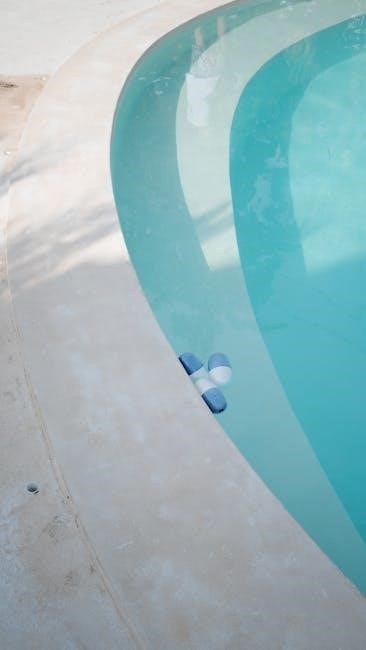Leslie’s Pool Opening Instructions provide a comprehensive guide to prepare your pool for summer. Their expert tips and essential kits simplify the process‚ ensuring a safe and enjoyable swimming experience.
Why Timely Pool Opening is Important
Timely pool opening is crucial to ensure your pool is clean‚ safe‚ and ready for use. Delaying the process can lead to algae growth‚ water contamination‚ and damage to equipment. Early opening allows you to address issues like debris accumulation and chemical imbalances before they escalate. Proper preparation also prevents costly repairs and extends the lifespan of your pool. Leslie’s instructions emphasize the importance of following a structured approach to maintain water quality and equipment functionality. By opening your pool on time‚ you ensure a hassle-free swimming season and create a safe environment for family and friends to enjoy.
Essential Tasks Before Starting the Pool Opening Process
Before opening your pool‚ several key tasks must be completed to ensure a smooth process. First‚ remove water from the pool cover using a submersible pump or siphon‚ and clean off any accumulated debris. Next‚ inspect the pool and surrounding equipment for damage or wear‚ addressing any issues immediately. Gather all necessary tools and chemicals‚ such as Leslie’s Pool Opening Kits‚ which include pre-measured treatments for up to 7‚500 gallons. These kits simplify the process by providing essential chemicals to balance water chemistry and prevent algae growth. Proper preparation now saves time and prevents potential problems later‚ ensuring your pool is safe and ready for use.

Preparing the Pool Area
Start by removing the pool cover and cleaning debris‚ then inspect the pool and surrounding equipment. Organize necessary tools and chemicals for a smooth process.
Removing the Pool Cover and Cleaning Debris
Start by carefully removing the pool cover‚ ensuring no debris remains attached. Use a submersible pump or siphon to eliminate standing water from the cover; Once removed‚ inspect and clean the cover thoroughly‚ storing it in a dry‚ protected area. Next‚ skim the pool surface to remove leaves and debris. Use a pool brush to scrub the walls and floor‚ loosening any dirt or algae. Vacuum the pool to collect all particles‚ ensuring the water is clear and free of contaminants. Properly cleaning the pool and cover ensures a smooth and safe opening process. Leslie’s Pool Opening Kits provide essential tools to simplify this step.
Inspecting the Pool and Surrounding Equipment
After removing the cover‚ inspect the pool and its surrounding equipment for damage or wear. Check the pool liner for tears or cracks and ensure all tiles and coping are secure. Examine the pump‚ filter‚ and heater for any signs of damage or corrosion. Look for leaks in pipes and connections. Test the functionality of valves and gauges. Inspect electrical components and ensure they are safe and operational. Also‚ check the condition of ladders‚ handrails‚ and diving boards. Address any issues before proceeding to ensure everything functions properly and safely. Leslie’s Pool Opening Kits include tools to help identify and resolve potential problems during this inspection phase.
Preparing Necessary Tools and Chemicals
Gather essential tools and chemicals before starting the pool opening process. Leslie’s Pool Opening Kits provide pre-measured chemicals‚ including shock treatment‚ stabilizer‚ and algaecide‚ to simplify the process. Ensure you have a skimmer‚ vacuum‚ and test strips for water analysis. A submersible pump and siphon are necessary for removing water from the cover. Keep a garden hose and scrub brush on hand for cleaning. Always follow the instructions on chemical labels‚ especially for winterized pools. Safety goggles and gloves are recommended when handling chemicals. Proper preparation ensures efficiency and safety‚ helping you achieve clean‚ balanced water for a successful pool opening.

Understanding Water Chemistry
Leslie’s Pool Opening Instructions emphasize the importance of balanced water chemistry. Proper pH‚ alkalinity‚ and chlorine levels ensure safe swimming and prevent equipment damage or cloudy water issues.
Importance of Testing Pool Water
Testing pool water is crucial for ensuring a safe and healthy swimming environment. Imbalanced chemicals can cause eye irritation‚ skin discomfort‚ and even damage pool equipment. Regular testing helps maintain optimal levels of pH‚ alkalinity‚ and chlorine‚ preventing algae growth and cloudy water. Leslie’s provides reliable testing kits to simplify this process. By monitoring water chemistry‚ you can address issues early‚ avoiding costly repairs and ensuring your pool remains crystal clear. Proper testing also extends the lifespan of your pool and equipment‚ making it a vital step in seasonal maintenance. Consistent water testing guarantees a clean‚ safe‚ and enjoyable swimming experience for everyone.
Key Parameters to Check: pH‚ Alkalinity‚ and Chlorine Levels
Testing for pH‚ alkalinity‚ and chlorine levels is essential for maintaining balanced pool water. The ideal pH range is 7.2–7.8‚ while alkalinity should be between 80–120 ppm to stabilize pH and prevent fluctuations. Chlorine levels should be 1–3 ppm for effective sanitation. Imbalanced pH can cause eye irritation and equipment damage‚ while low alkalinity leads to unstable water chemistry. Proper chlorine levels ensure clean water and prevent algae growth. Using Leslie’s testing kits‚ you can accurately measure these parameters. Adjustments should be made gradually to avoid over-correction. Regular monitoring ensures a safe‚ clear‚ and comfortable swimming environment‚ extending the life of your pool and equipment.

Balancing Pool Chemicals
Balancing pool chemicals ensures safe and efficient water conditions. Proper pH‚ alkalinity‚ and chlorine levels prevent eye irritation‚ equipment damage‚ and algae growth. Leslie’s kits simplify this process.
Adjusting pH Levels for Safe Swimming
Adjusting pH levels is crucial for safe swimming and equipment protection. The ideal pH range for pool water is between 7.2 and 7.8. Test the water using a reliable kit to determine the current pH level. If the pH is too low‚ add a pH increaser; if too high‚ use a pH decreaser. Always follow the manufacturer’s instructions for proper dosage. Allow the pool to circulate for at least 30 minutes after adjustments to ensure even distribution. Retest the water to confirm the pH is within the safe range. Regular monitoring and small adjustments will help maintain stability and prevent eye irritation or equipment damage.

Stabilizing Alkalinity to Prevent Fluctuations
Stabilizing alkalinity is essential to prevent pH fluctuations in your pool water. The recommended alkalinity level is between 80-120 ppm. Test the water and adjust as needed. If alkalinity is low‚ add an alkalinity increaser according to the product’s instructions. High alkalinity may require draining some water and refilling. Proper alkalinity levels protect equipment from corrosion and prevent eye irritation. Regular testing ensures stability and maintains optimal water balance. Leslie’s Pool Opening Kits include the necessary chemicals to achieve and maintain the correct alkalinity levels‚ ensuring a safe and enjoyable swimming environment throughout the season.
Filtration System Setup
Filtration system setup is crucial for clean water. Inspect and clean the filter‚ prime the pump‚ and ensure proper circulation. Leslie’s kits provide essential tools for optimal function.
Prepping the Pool Pump and Filter
Before opening your pool‚ ensure the pump and filter are ready for operation. Reassemble any components disconnected during winterization and check for worn or damaged seals. Prime the pump according to the manufacturer’s instructions to remove air locks. For cartridge filters‚ clean or replace the cartridge‚ while sand filters may need backwashing. DE filters require recharging with fresh filter powder. Test the system by running the pump at low speed to ensure smooth water flow. Address any leaks or unusual noises promptly. Properly prepping these components ensures efficient circulation and filtration‚ crucial for maintaining clean and safe pool water throughout the season.
Ensuring Proper Circulation and Filtration
Once your pump and filter are prepped‚ ensure proper circulation and filtration by running the system continuously for the first 24-48 hours. This helps remove embedded contaminants and stabilizes water chemistry. Check the skimmer and pump baskets daily‚ cleaning them as needed to maintain optimal flow. Backwash or clean the filter according to the manufacturer’s schedule to prevent clogging. Ensure all valves are set correctly for normal operation‚ and inspect pipes for leaks. Proper circulation and filtration are essential for maintaining clear‚ clean water and preventing algae growth. Regularly monitor the system’s performance to ensure it runs efficiently throughout the season.

Sanitizing the Pool
Shock treat the water to eliminate contaminants and add stabilizer to protect chlorine. Always test the water before sanitizing to ensure safe and effective results.

Shock Treating the Pool Water
Shock treating is a critical step in pool opening to remove contaminants and oxidize organic matter. Leslie’s recommends using a high-strength chlorine shock treatment to eliminate embedded dirt and algae; This process ensures clear water and prevents future issues. Apply the shock treatment in the evening to avoid sunlight interference. Always follow the product instructions for proper dosing. After shocking‚ allow the filter to run overnight to circulate and clean the water thoroughly. Regular shock treatments maintain water clarity and sanitizer efficiency‚ ensuring a safe and enjoyable swimming environment. Leslie’s Chlorine Shock is a reliable choice for this essential task.
Adding Stabilizer to Protect Chlorine
Adding a stabilizer is essential to protect chlorine from sunlight degradation‚ ensuring its effectiveness. Leslie’s Chlorine Stabilizer helps maintain consistent chlorine levels‚ preventing rapid depletion. Apply the stabilizer according to the product instructions‚ typically by broadcasting it evenly over the pool surface. Allow the filter to circulate the water for a few hours before testing the chlorine levels again. Proper stabilizer levels (40-100 ppm) are crucial for chlorine efficiency and swimmer safety. Leslie’s Stabilizer is designed to work seamlessly with their pool opening kits‚ ensuring your pool remains clean and well-maintained throughout the season. This step is vital for long-term water clarity and sanitizer performance.

Removing Stains and Algae
Leslie’s guide helps identify and treat stains and algae effectively‚ ensuring a clean pool. Use specialized treatments and maintain proper circulation to prevent regrowth and keep water clear.
Identifying and Treating Different Types of Stains
Identifying pool stains is crucial for effective treatment. Metal stains‚ often from iron or copper‚ appear as blue-green or brown spots. Organic stains‚ like those from leaves‚ are typically brown or black. Rust stains are reddish-orange and usually come from corroded equipment. Once identified‚ treat metal stains with a metal remover or sequestering agent. For organic stains‚ shock the pool and use an enzyme-based cleaner. Rust stains may require a rust remover or adjusting the water chemistry. Always test the water after treatment to ensure proper balance. Leslie’s offers specialized products to tackle these issues‚ ensuring your pool remains clean and stain-free for a pristine swimming experience.
Effective Methods for Algae Removal
Effective algae removal requires a combination of shock treatment and targeted cleaning. Start by shocking the pool to eliminate algae and organic matter‚ then run the filter continuously to trap dead algae. Use an algaecide to prevent regrowth‚ choosing non-foaming formulas for cartridge filters. Brush the pool walls and floor to loosen stubborn algae. Ensure proper pH levels before adding chemicals‚ as imbalanced water can reduce treatment effectiveness. For persistent algae‚ consider using a clarifier to improve water clarity. Leslie’s offers specialized algaecide products designed to tackle green‚ black‚ or mustard algae effectively. Regular maintenance and monitoring will help keep your pool algae-free and sparkling throughout the season.

Safety Precautions
Always handle pool chemicals with care‚ wearing gloves and goggles. Avoid inhaling fumes and keep children away. Ensure proper ventilation and follow Leslie’s guidelines for safe use.
Handling Pool Chemicals Safely
When handling pool chemicals‚ safety is paramount to avoid accidents and ensure effective pool maintenance. Always wear protective gloves and goggles to prevent skin and eye irritation. Read and follow the instructions on each chemical label carefully‚ as improper use can lead to dangerous reactions. Never mix different chemicals‚ as this can release harmful gases or cause violent reactions. Add chemicals to the water in the recommended order and quantities to maintain proper balance. Store chemicals in a cool‚ dry‚ well-ventilated area away from children and pets. Dispose of empty containers properly‚ following local regulations. Keep the pool area well-ventilated when handling chemicals to prevent inhaling fumes. In case of accidental exposure‚ rinse affected areas with water and seek medical attention if necessary. Proper handling ensures a safe and enjoyable swimming environment.

Maintenance Tips
Maintain your pool’s clarity and safety by skimming regularly and cleaning the filter. Leslie’s kits provide everything needed to keep your pool pristine all season long.
Regular Cleaning and Skimming
Regular cleaning and skimming are essential for maintaining a pristine pool environment. Start by skimming the surface daily to remove floating debris like leaves and insects. Use a pool skimmer or leaf net for this task‚ ensuring the water remains clear and free of contaminants. Additionally‚ vacuum the pool floor weekly to eliminate dirt and sediment that can cloud the water. Brush the pool walls and tiles to prevent algae buildup‚ especially in areas with poor circulation. For added efficiency‚ consider using an automatic pool cleaner to handle debris while you focus on other tasks. Leslies Pool Opening Kits include products to support these routines‚ making it easier to keep your pool clean and inviting all season long.
Scheduling Routine Maintenance
Scheduling routine maintenance ensures your pool remains in optimal condition throughout the season. Create a weekly plan that includes checking chemical levels‚ cleaning filters‚ and inspecting equipment for wear and tear. Monthly tasks should involve deep cleaning the pool floor‚ inspecting the pool liner for damage‚ and servicing the pump and filter system. Leslies Pool Opening Kits provide the necessary chemicals and tools to streamline these processes. By adhering to a consistent maintenance schedule‚ you can prevent issues like cloudy water or equipment malfunctions‚ ensuring a safe and enjoyable swimming environment; Regular maintenance also extends the lifespan of your pool and its components‚ saving you time and money in the long run.
Troubleshooting Common Issues
Troubleshooting common issues during pool opening ensures quick resolution of problems like cloudy water or equipment malfunctions‚ helping you maintain a safe and enjoyable swimming environment.
Addressing Cloudy or Discolored Water
Cloudy or discolored water can occur due to imbalanced chemicals‚ poor filtration‚ or debris. To resolve this‚ test and adjust pH‚ alkalinity‚ and chlorine levels. Shock treatment may be necessary to eliminate contaminants. Ensure the filtration system is running correctly and backwash if needed. Regular skimming and vacuuming can also help clarify the water. Leslie’s kits often include clarifiers to enhance water clarity. If issues persist‚ consider professional assistance to identify underlying problems. Proper maintenance and chemical balance are key to achieving clear‚ safe swimming water.
Fixing Equipment Malfunctions
Equipment malfunctions can disrupt pool operations; Common issues include faulty pumps‚ clogged filters‚ or non-functioning heaters. Start by turning off the power and inspecting for blockages or worn parts. Clean or replace filters as needed and check for leaks. If the pump isn’t priming‚ ensure proper water levels and bleed air from the system. For complex problems‚ consult Leslie’s troubleshooting guides or contact a professional. Regular maintenance can prevent many issues‚ ensuring smooth operation and extending equipment lifespan. Always follow safety guidelines when handling electrical components to avoid accidents.
Leslie’s Pool Opening Instructions ensure a smooth transition from winter to summer. Follow their expert guidance for a safe‚ clean‚ and enjoyable swimming experience all season long.
Final Checklist for a Successful Pool Opening
To ensure a seamless pool opening‚ follow this checklist:
Remove and clean the pool cover thoroughly.
Inspect the pool‚ equipment‚ and surroundings for damage or wear.
Gather all necessary tools and chemicals‚ including Leslie’s Pool Opening Kits.
Test and balance water chemistry‚ adjusting pH‚ alkalinity‚ and chlorine levels.
Shock treat the water and add stabilizer to protect chlorine.
Prime the pool pump and filter‚ ensuring proper circulation.
Address any stains or algae growth promptly.
Skim the surface‚ vacuum the floor‚ and clean the tiles.
Schedule routine maintenance to maintain clarity and safety.
By completing these steps‚ your pool will be ready for a safe and enjoyable swimming season. Always refer to Leslie’s instructions for specific guidance.
